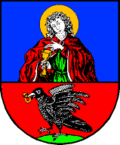Golling an der Salzach | |
|---|---|
 Town centre | |
| Coordinates: 47°36′00″N13°10′00″E / 47.60000°N 13.16667°E | |
| Country | Austria |
| State | Salzburg |
| District | Hallein |
| Government | |
| • Mayor | Anton Kaufmann (ÖVP) |
| Area | |
• Total | 82.2 km2 (31.7 sq mi) |
| Elevation | 476 m (1,562 ft) |
| Population (2018-01-01) [2] | |
• Total | 4,271 |
| • Density | 52/km2 (130/sq mi) |
| Time zone | UTC+1 (CET) |
| • Summer (DST) | UTC+2 (CEST) |
| Postal code | 5440 |
| Area code | 0 62 44 |
| Vehicle registration | HA |
| Website | www.golling.salzburg.at |
Golling an der Salzach is a market town in the Hallein district of Salzburg, Austria.


